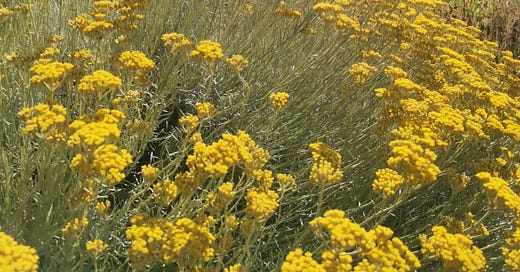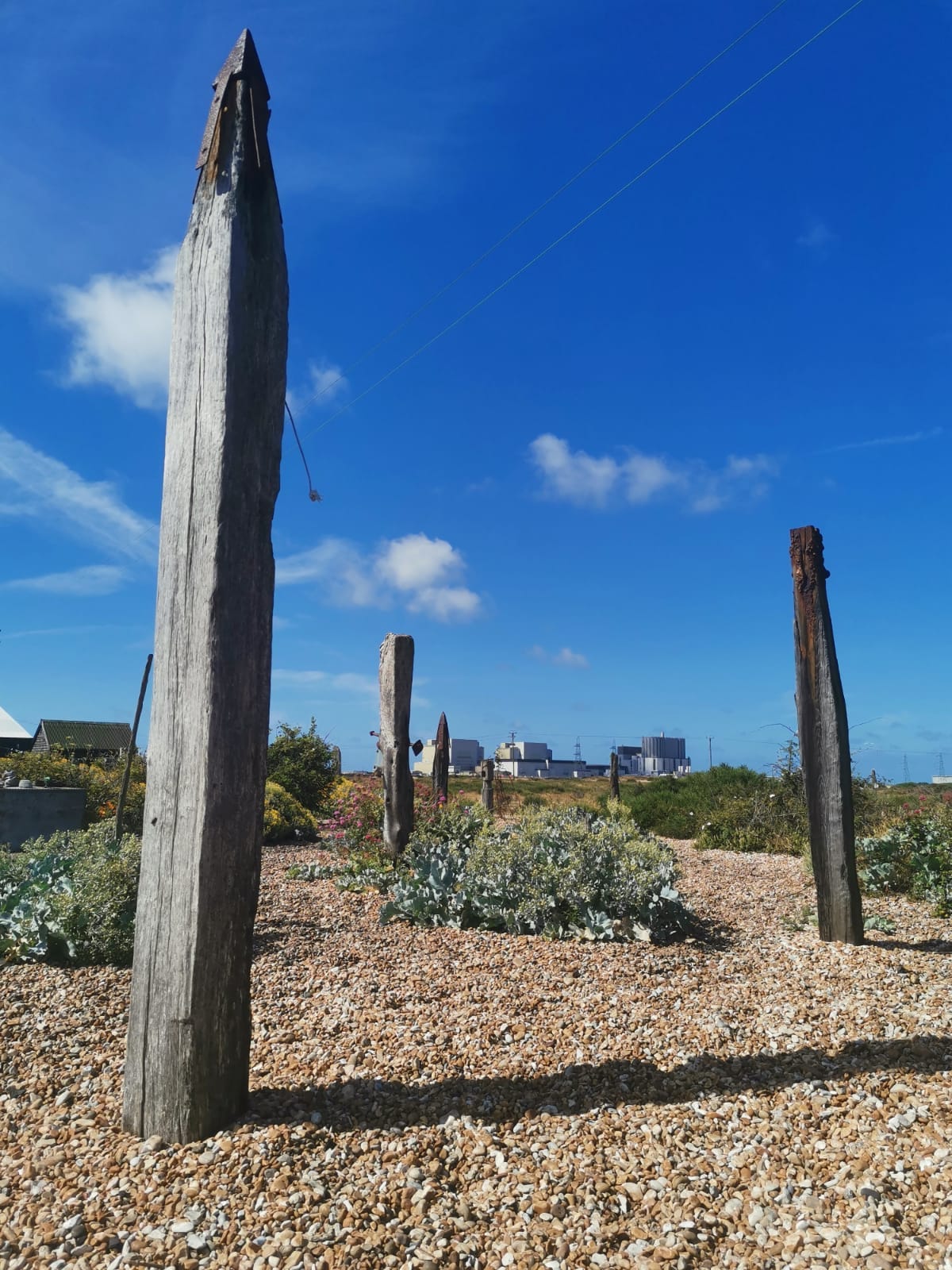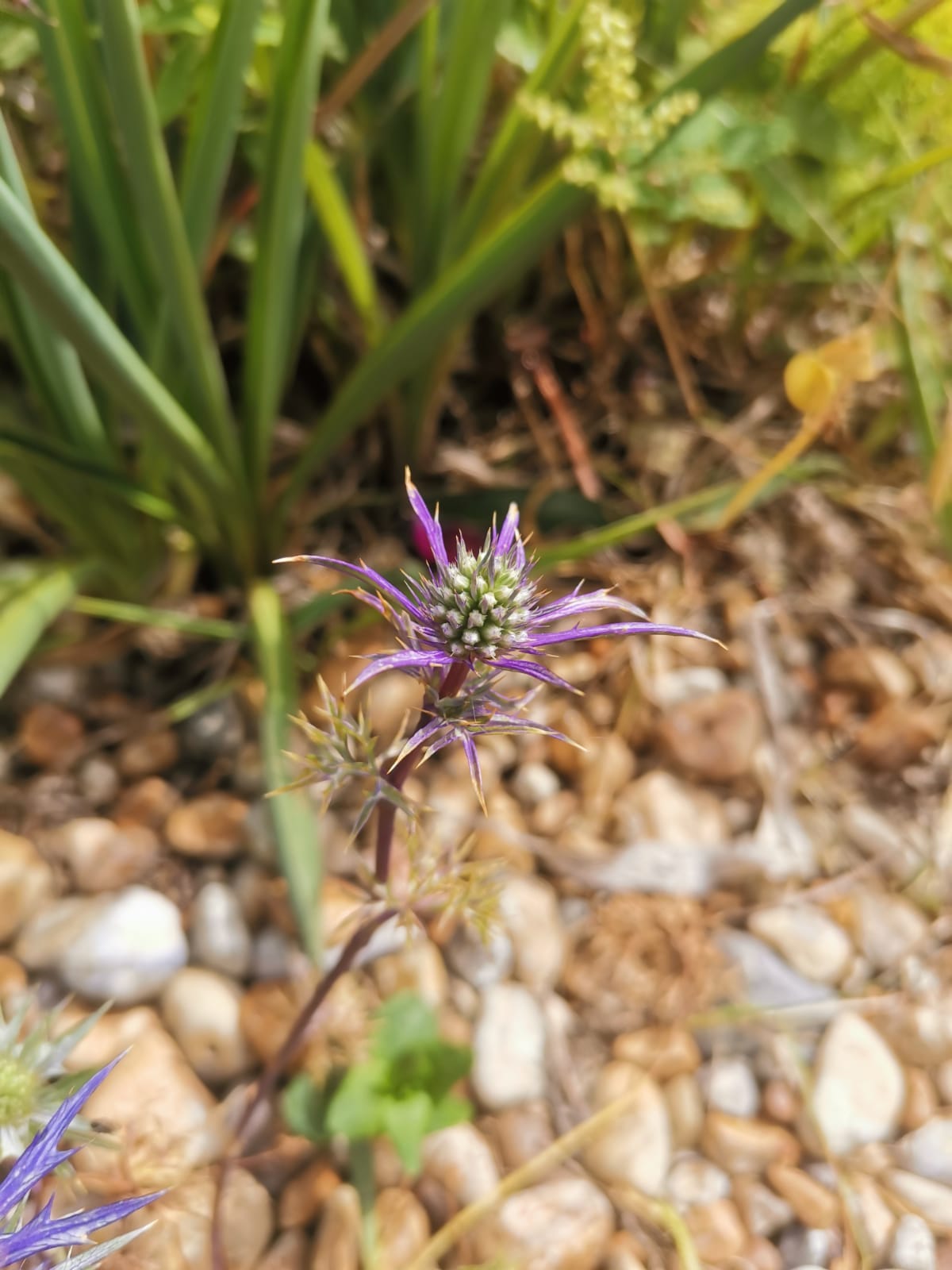A few weeks ago, Jonny Bruce, who takes care of the garden originally created by Derek Jarman at Prospect Cottage, got in touch to say he had space available on a working weekend at the garden and did I know anyone who might be interested. The garden, and I don’t think it’s hyperbole to describe it as legendary, at Prospect Cottage means a great deal to a great many people. For some it is a place of pilgrimage. A queer paradise, a radical garden, made against the odds, a garden as art and resistance and celebration, set in a remarkable location… It is unconventional, inspirational, transporting and otherworldly. It was an opportunity not to be missed and whilst I was very sad not to be able to make it myself, I’m so thrilled that Carmen, who has contributed to Radicle previously, was able to take part and agreed to share with us a little bit about her weekend spent gardening and staying at the cottage.
Gardening at Prospect Cottage, by Carmen Sheridan
At first glimpse, the landscape of Dungeness looks bleak and barren - the nuclear power station looming heavy on the horizon, pylon wires snaking the sky; a sky that feels vaster here somehow. But as you look closer, colour emerges - spikes of blue Echium erupting from golden, wind-scorched grass; sea kale adorned with berry baubles; the acid hit of the yellow-horned poppy. As we approach Prospect Cottage, these pops of colour blast into the glorious technicolour of Derek Jarman’s garden.
In 1987, whilst filming on the beach at Dungeness, Jarman stumbled across the fisherman’s cottage that later would become Prospect. He bought it that same day. No soil lay below the shingle, this was later added in - digging in sacks of manure to accommodate thirsty roses. Jarman defiantly planted in inhospitable and unlikely conditions. Driftwood sculptures were erected, flint stones and shells collected from the beach at low tide to mark out beds, and necklaces of holey stones strung to serve as talismans. At Dungeness, regulations prohibit the construction of fences around properties; the garden, as a result, tumbles out into the wider landscape, just as the wider landscape merges into the garden - boundaryless - gifting one another.
Jarman began planting the garden shortly after his diagnosis of HIV. Many of his loved ones were losing their lives to the disease and faced with the end of his, he began to garden. A defiant act, the garden was resistance to ingrained homophobia and to a society that was ignoring the death of so many queer people. It was radical, political and a space to honour queerness: “Before I finish, I intend to celebrate our garden, the part of the garden the Lord forgot to mention”. The garden is described as his final art piece, even a self-portrait.
Derek died in 1994 and his garden was cared for and maintained for the following 19 years by his partner Keith Collins. Before Keith died, he asked gardener and horticulturist Jonny Bruce to take care of it and continue the legacy. Jonny sensitively tends to the garden, holding onto the history and Jarman’s original planting whilst also finding ways to continue the experimental approach. He hosts student weekends to build a community around the garden - a space for learning about its queer history, Jarman, and gardening outside the restraints of convention. As Jonny says at one point, much of gardening at Prospect is about looking and noticing.
I was lucky enough to spend the weekend gardening here as part of the volunteer and student group. Over the two days, we worked together restoring one of the railway sleeper beds. These were originally constructed by Jarman for growing vegetables, but as his health deteriorated, the upkeep of these became unmanageable. One of these reinstated beds will house medicinal and herbal plants - Jarman was interested in the healing properties of plants and their folkloric roots, seeing the garden as a living Pharmacopoeia. The second, which we work on, will become a nursery bed for raising and trialling young plants for the garden. We clear it out and barrows of sand are filled and wheeled, tipped into the bed and raked to a level. The sand drains well, ensuring roots don’t get too wet and holds few nutrients: the plants, in searching for these, build up a strong root network. Jonny’s approach to gardening at Prospect is imbued with the experimental, trialling new horticultural techniques to continue the evolution of the garden, in the spirit of Derek’s creation.
Later, we ‘re-plant’ Derek’s collected flints - his “dragon’s teeth” which he arranged carefully into monolithic stone circles. The flints tumbled by the sea into weird and wonderful shapes, decorated with intricate lichens, each a piece of art in its own right. As we plant, Jonny explains the protective nature of the garden - the flints and towering sculptures symbolising a battalion, the garden a fortress; guarding against society’s hostility, Thatcherism and acting as a protector of his health.
As we attentively place these stones, I am struck by the stories that each carries - a story of the passage of time, shaped by the sea, their history felt through this. I become aware of how this mirrors our lives - the tides of life that shape us, the peaks and troughs woven through our bodies. The powerful and transformative act of gardening feels so present at Prospect - the garden as a microcosm of life. It affirms what truly matters and reveals a philosophy to live by; to seek creativity, passion, growth and experimentation - to revel in the boundless joys of plants and nature. In Derek’s planting, I see the interplays of life - the political, spiritual, creative and mystical - the garden a projection of self, soul and life. As Jarman wrote, in words that move:
“The gardener digs in another time, without past or future, beginning or end. A time that does not leave the day with rush hours, lunch breaks, the last bus home. As you walk in the garden you pass into this time — the moment of entering can never be remembered. Around you the landscape lies transfigured. Here is the Amen beyond the prayer.”
The time I spent gardening at Prospect was a lesson in attention. En route to Dungeness, my phone switched off and wouldn’t charge for the rest of the weekend. When I returned home, it began working as normal. It felt like a message. Recently, I have been stuck on a conveyor belt - rushing through life, caught in a never-ending checklist and lacking presence. I record endless moments on my phone, anxious to let one go by undocumented. Gardening here highlighted the importance of stepping back and slowing down - to closely attend and listen.
As we garden together as a group, we come together as a community - excitement and warmth is tangible, fed by the specialness of the place and the openness with which Jonny welcomes us. We are invited to look closer and reflect on the importance of empty space in the garden; the punctuation between plants. As we carefully remove and thin out plants from the shingle, we talk about passages through life and share our love and appreciation of gardens and plants - all humming with awe over the beauty of a poppy with blue pollen! In the evening, with mugs of steaming ginger tea, we chat and turn the lights off to bask in the eerie glow of the power station - Derek referred to it as the Emerald City. There’s an otherworldly quality here, as though you have been transported to another place.
A note on the front door of the cottage reads: “Was fishing. Now I’m sleeping. Sssh!”. As you step inside, it feels like arriving home. The root of the word ‘home’ stems from the same used for people - ‘homo’ - and here, the cottage feels alive with Derek and Keith, holding a deep humanity and animacy. The walls adorned with art, found objects and flotsam from the beach - all seem to hold the tenderness with which Derek saw them. Bookshelves are full showing a life of learning and curiosity. The garden too holds this humanity and expression of self - the echoes of those that tended to and loved it are still present.
I reflect on what it means to garden, what is a garden and how it should feel - how we should be moved, challenged and inspired. I garden as my job, but to me, it will always be more than that - it is a relationship that fills my heart, gives me space and helps me to see the world in different ways. It’s an act that supports me to make sense of life. This is so evident in Derek’s garden - a reflection of his life and experiences, as well as a response to the politics of the time. It is a space of freedom, experimentation and a celebration of life and all its fluctuations. It is a space where the love and joy that Derek gardened can be palpably read and experienced, as he wrote:
“Every flower is a triumph. I’ve had more fun at this place than I’ve had with anything else in my life”
Thank you to Jonny Bruce @j.bruce.garden for hosting, sharing the garden and his knowledge so generously.
To find out more about Prospect Cottage : https://www.creativefolkestone.org.uk/news/2020/04/derek-jarmans-prospect-cottage-saved-for-the-nation/
References:
Derek Jarman - Modern Nature
Derek Jarman ‘My Garden’s Boundaries are the Horizon’ - Garden Museum
Carmen is a gardener living in Brighton, currently completing a botanical-horticulture apprenticeship at Wakehurst. She finds great joy and support in learning and connecting with plants. She also co-creates and edits Florxl zine - an inclusive, accessible zine that celebrates the joy of plants, horticulture and gardens, bringing together a range of writers, artists and passionate plant lovers - all profits go to the Lemon Tree Trust. You can find her on Instagram @_carmengardens and @florxl_zine.
Carmen is being paid for this article.
Photo credits: Carmen Sheridan







